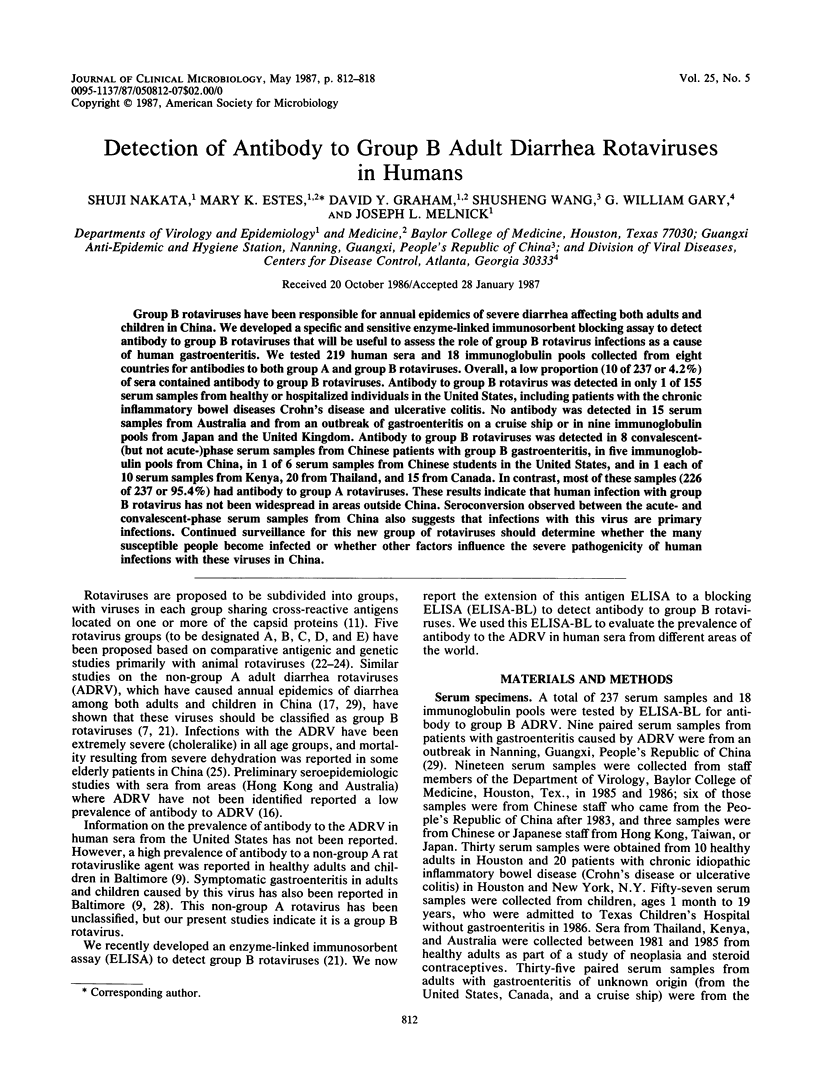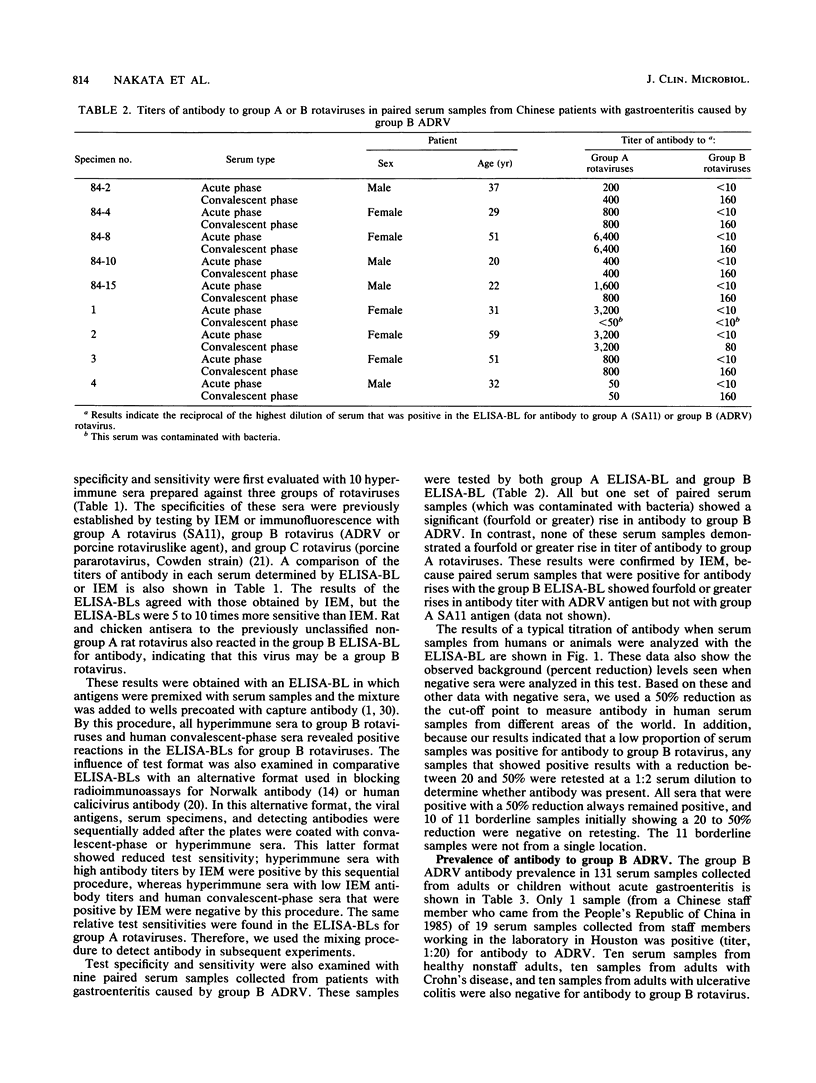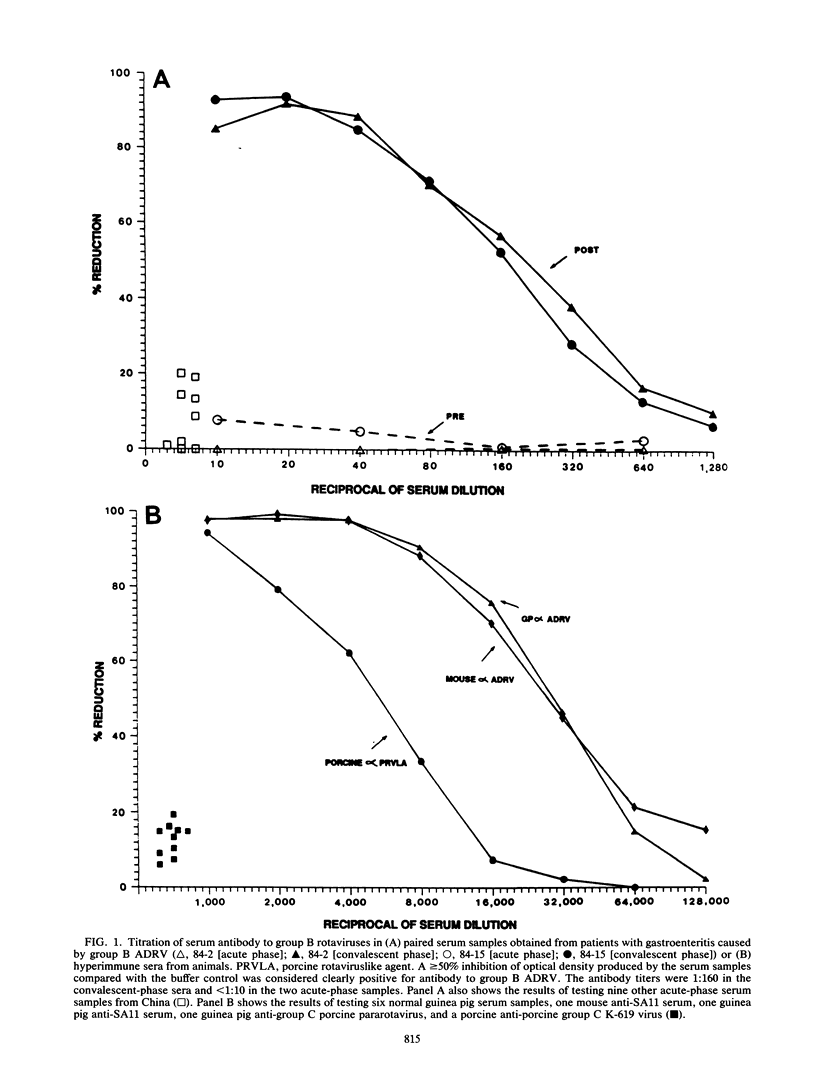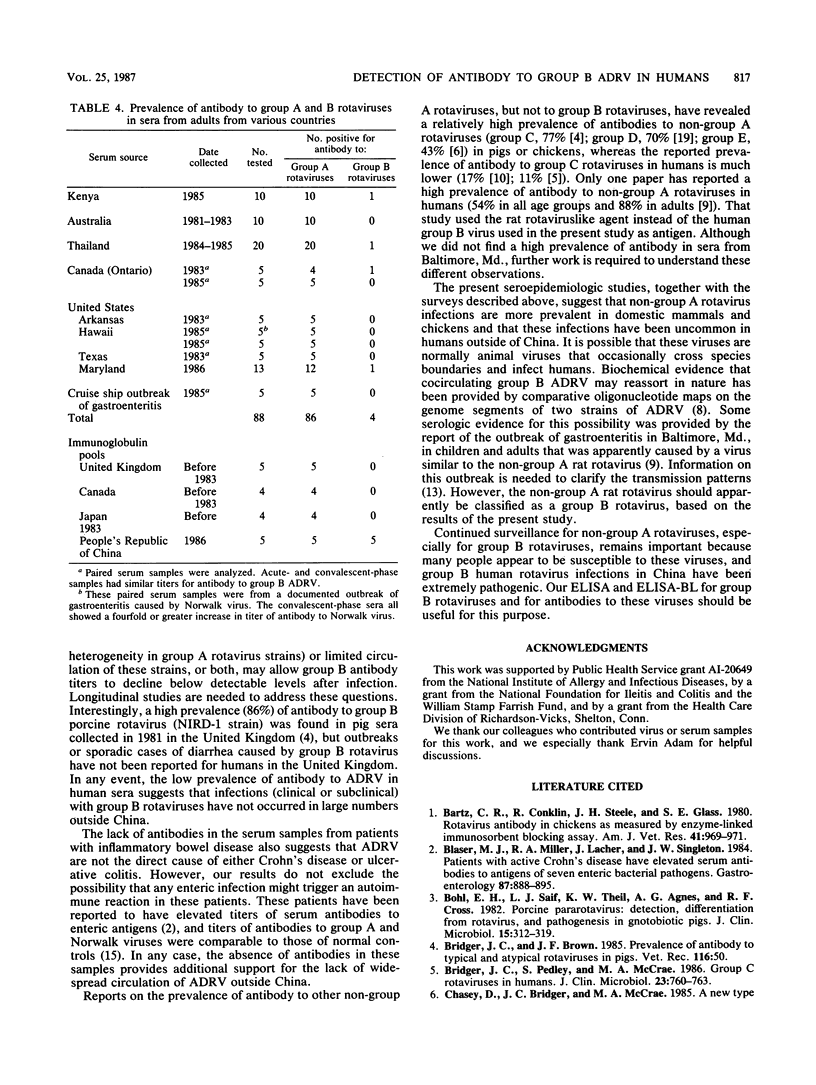Abstract
Group B rotaviruses have been responsible for annual epidemics of severe diarrhea affecting both adults and children in China. We developed a specific and sensitive enzyme-linked immunosorbent blocking assay to detect antibody to group B rotaviruses that will be useful to assess the role of group B rotavirus infections as a cause of human gastroenteritis. We tested 219 human sera and 18 immunoglobulin pools collected from eight countries for antibodies to both group A and group B rotaviruses. Overall, a low proportion (10 of 237 or 4.2%) of sera contained antibody to group B rotaviruses. Antibody to group B rotavirus was detected in only 1 of 155 serum samples from healthy or hospitalized individuals in the United States, including patients with the chronic inflammatory bowel diseases Crohn's disease and ulcerative colitis. No antibody was detected in 15 serum samples from Australia and from an outbreak of gastroenteritis on a cruise ship or in nine immunoglobulin pools from Japan and the United Kingdom. Antibody to group B rotaviruses was detected in 8 convalescent-(but not acute-)phase serum samples from Chinese patients with group B gastroenteritis, in five immunoglobulin pools from China, in 1 of 6 serum samples from Chinese students in the United States, and in 1 each of 10 serum samples from Kenya, 20 from Thailand, and 15 from Canada. In contrast, most of these samples (226 of 237 or 95.4%) had antibody to group A rotaviruses. These results indicate that human infection with group B rotavirus has not been widespread in areas outside China. Seroconversion observed between the acute-and convalescent-phase serum samples from China also suggests that infections with this virus are primary infections. Continued surveillance for this new group of rotaviruses should determine whether the many susceptible people become infected of whether other factors influence the severe pathogenicity of human infections with these viruses in China.
Full text
PDF






Selected References
These references are in PubMed. This may not be the complete list of references from this article.
- Bartz C. R., Conklin R., Steele J. H., Glass S. E. Rotavirus antibody in chickens as measured by enzyme-linked immunosorbent blocking assay. Am J Vet Res. 1980 Jun;41(6):969–971. [PubMed] [Google Scholar]
- Blaser M. J., Miller R. A., Lacher J., Singleton J. W. Patients with active Crohn's disease have elevated serum antibodies to antigens of seven enteric bacterial pathogens. Gastroenterology. 1984 Oct;87(4):888–894. [PubMed] [Google Scholar]
- Bohl E. H., Saif L. J., Theil K. W., Agnes A. G., Cross R. F. Porcine pararotavirus: detection, differentiation from rotavirus, and pathogenesis in gnotobiotic pigs. J Clin Microbiol. 1982 Feb;15(2):312–319. doi: 10.1128/jcm.15.2.312-319.1982. [DOI] [PMC free article] [PubMed] [Google Scholar]
- Bridger J. C., Brown J. F. Prevalence of antibody to typical and atypical rotaviruses in pigs. Vet Rec. 1985 Jan 12;116(2):50–50. doi: 10.1136/vr.116.2.50. [DOI] [PubMed] [Google Scholar]
- Bridger J. C., Pedley S., McCrae M. A. Group C rotaviruses in humans. J Clin Microbiol. 1986 Apr;23(4):760–763. doi: 10.1128/jcm.23.4.760-763.1986. [DOI] [PMC free article] [PubMed] [Google Scholar]
- Chen C. M., Hung T., Bridger J. C., McCrae M. A. Chinese adult rotavirus is a group B rotavirus. Lancet. 1985 Nov 16;2(8464):1123–1124. doi: 10.1016/s0140-6736(85)90710-x. [DOI] [PubMed] [Google Scholar]
- Desselberger U., Hung T., Follett E. A. Genome analysis of human rotaviruses by oligonucleotide mapping of isolated RNA segments. Virus Res. 1986 Jun;4(4):357–368. doi: 10.1016/0168-1702(86)90082-1. [DOI] [PubMed] [Google Scholar]
- Eiden J., Vonderfecht S., Yolken R. H. Evidence that a novel rotavirus-like agent of rats can cause gastroenteritis in man. Lancet. 1985 Jul 6;2(8445):8–11. doi: 10.1016/s0140-6736(85)90057-1. [DOI] [PubMed] [Google Scholar]
- Espejo R. T., Puerto F., Soler C., González N. Characterization of a human pararotavirus. Infect Immun. 1984 Apr;44(1):112–116. doi: 10.1128/iai.44.1.112-116.1984. [DOI] [PMC free article] [PubMed] [Google Scholar]
- Estes M. K., Graham D. Y. Rotavirus antigens. Adv Exp Med Biol. 1985;185:201–214. doi: 10.1007/978-1-4684-7974-4_13. [DOI] [PubMed] [Google Scholar]
- Estes M. K., Graham D. Y., Smith E. M., Gerba C. P. Rotavirus stability and inactivation. J Gen Virol. 1979 May;43(2):403–409. doi: 10.1099/0022-1317-43-2-403. [DOI] [PubMed] [Google Scholar]
- Graham D. Y., Estes M. K. Rotavirus-like agent, rats, and man. Lancet. 1985 Oct 19;2(8460):886–886. doi: 10.1016/s0140-6736(85)90147-3. [DOI] [PubMed] [Google Scholar]
- Greenberg H. B., Gebhard R. L., McClain C. J., Soltis R. D., Kapikian A. Z. Antibodies to viral gastroenteritis viruses in Crohn's disease. Gastroenterology. 1979 Feb;76(2):349–350. [PubMed] [Google Scholar]
- Greenberg H. B., Wyatt R. G., Valdesuso J., Kalica A. R., London W. T., Chanock R. M., Kapikian A. Z. Solid-phase microtiter radioimmunoassay for detection of the Norwalk strain of acute nonbacterial, epidemic gastroenteritis virus and its antibodies. J Med Virol. 1978;2(2):97–108. doi: 10.1002/jmv.1890020204. [DOI] [PubMed] [Google Scholar]
- Hung T., Chen G. M., Wang C. G., Yao H. L., Fang Z. Y., Chao T. X., Chou Z. Y., Ye W., Chang X. J., Den S. S. Waterborne outbreak of rotavirus diarrhoea in adults in China caused by a novel rotavirus. Lancet. 1984 May 26;1(8387):1139–1142. [PubMed] [Google Scholar]
- Hung T., Fan R. L., Wang C. A., Chen G. M., Chou D. N., Chang J. Q., McCrae M. A., Wang W. Z., Se W. Z., Dan R. Seroepidemiology of adult rotavirus. Lancet. 1985 Aug 10;2(8450):325–326. [PubMed] [Google Scholar]
- Mason B. B., Graham D. Y., Estes M. K. In vitro transcription and translation of simian rotavirus SA11 gene products. J Virol. 1980 Mar;33(3):1111–1121. doi: 10.1128/jvi.33.3.1111-1121.1980. [DOI] [PMC free article] [PubMed] [Google Scholar]
- McNulty M. S., Allan G. M., McFerran J. B. Prevalence of antibody to conventional and atypical rotaviruses in chickens. Vet Rec. 1984 Mar 3;114(9):219–219. doi: 10.1136/vr.114.9.219. [DOI] [PubMed] [Google Scholar]
- Nakata S., Chiba S., Terashima H., Sakuma Y., Kogasaka R., Nakao T. Microtiter solid-phase radioimmunoassay for detection of human calicivirus in stools. J Clin Microbiol. 1983 Feb;17(2):198–201. doi: 10.1128/jcm.17.2.198-201.1983. [DOI] [PMC free article] [PubMed] [Google Scholar]
- Nakata S., Estes M. K., Graham D. Y., Loosle R., Tao H., Wang S. H., Saif L. J., Melnick J. L. Antigenic characterization and ELISA detection of adult diarrhea rotaviruses. J Infect Dis. 1986 Sep;154(3):448–455. doi: 10.1093/infdis/154.3.448. [DOI] [PubMed] [Google Scholar]
- Pedley S., Bridger J. C., Chasey D., McCrae M. A. Definition of two new groups of atypical rotaviruses. J Gen Virol. 1986 Jan;67(Pt 1):131–137. doi: 10.1099/0022-1317-67-1-131. [DOI] [PubMed] [Google Scholar]
- Snodgrass D. R., Herring A. J., Campbell I., Inglis J. M., Hargreaves F. D. Comparison of atypical rotaviruses from calves, piglets, lambs and man. J Gen Virol. 1984 May;65(Pt 5):909–914. doi: 10.1099/0022-1317-65-5-909. [DOI] [PubMed] [Google Scholar]
- Su C. Q., Wu Y. L., Shen H. K., Wang D. B., Chen Y. H., Wu D. M., He L. N., Yang Z. L. An outbreak of epidemic diarrhoea in adults caused by a new rotavirus in Anhui Province of China in the summer of 1983. J Med Virol. 1986 Jun;19(2):167–173. doi: 10.1002/jmv.1890190210. [DOI] [PubMed] [Google Scholar]
- Theil K. W., Saif L. J. In vitro detection of porcine rotavirus-like virus (group B rotavirus) and its antibody. J Clin Microbiol. 1985 May;21(5):844–846. doi: 10.1128/jcm.21.5.844-846.1985. [DOI] [PMC free article] [PubMed] [Google Scholar]
- Theil K. W., Saif L. J., Moorhead P. D., Whitmoyer R. E. Porcine rotavirus-like virus (group B rotavirus): characterization and pathogenicity for gnotobiotic pigs. J Clin Microbiol. 1985 Mar;21(3):340–345. doi: 10.1128/jcm.21.3.340-345.1985. [DOI] [PMC free article] [PubMed] [Google Scholar]
- Vonderfecht S. L., Huber A. C., Eiden J., Mader L. C., Yolken R. H. Infectious diarrhea of infant rats produced by a rotavirus-like agent. J Virol. 1984 Oct;52(1):94–98. doi: 10.1128/jvi.52.1.94-98.1984. [DOI] [PMC free article] [PubMed] [Google Scholar]
- Wang S. S., Cai R. F., Chen J., Li R. J., Jiang R. S. Etiologic studies of the 1983 and 1984 outbreaks of epidemic diarrhea in Guangxi. Intervirology. 1985;24(3):140–146. doi: 10.1159/000149633. [DOI] [PubMed] [Google Scholar]
- Yolken R. H., Wyatt R. G., Barbour B. A., Kim H. W., Kapikian A. Z., Chanock R. M. Measurement of rotavirus antibody by an enzyme-linked immunosorbent assay blocking assay. J Clin Microbiol. 1978 Sep;8(3):283–287. doi: 10.1128/jcm.8.3.283-287.1978. [DOI] [PMC free article] [PubMed] [Google Scholar]


